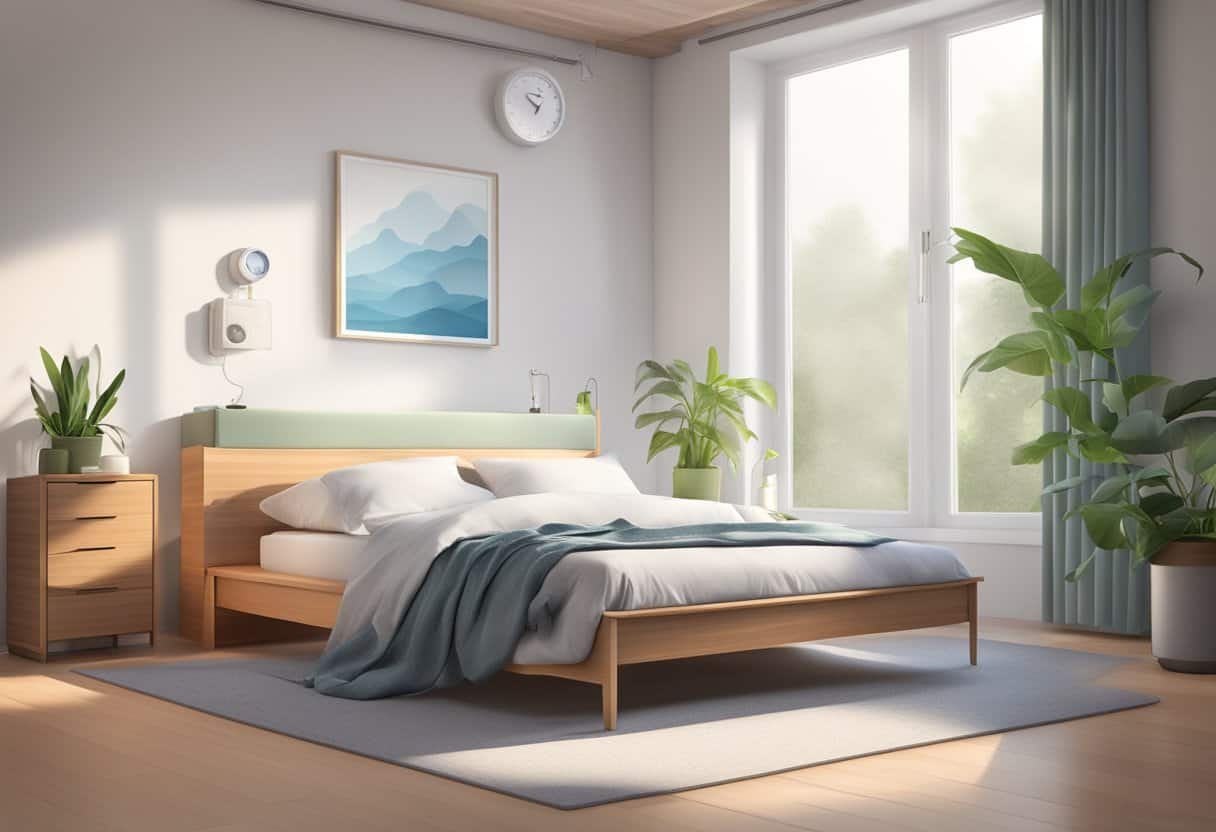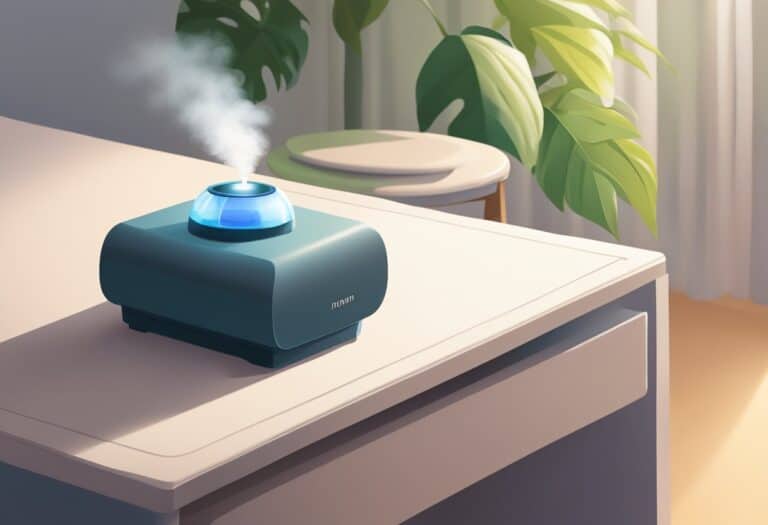Adequate sleep is fundamental for overall health, and numerous factors contribute to its quality, one of which is humidity.
Humidity refers to the amount of water vapor present in the air, and its levels in your sleeping environment can significantly affect your comfort and the restfulness of your sleep. Too much humidity can make you feel uncomfortably warm and may disrupt your sleep by causing sweating and dehydration. On the other hand, air that’s too dry can lead to irritation of your respiratory pathways, dry skin, and nasal passages, potentially causing snoring or discomfort that interrupts your sleep.
Identifying the ideal humidity level for sleeping is key to enhancing sleep quality, as it can help to ensure a comfortable environment that aligns with your body’s natural preferences. Generally, maintaining a humidity level of between 30% and 50% is often recommended for optimal sleep because it strikes a balance between being too moist and too dry. Specific devices, like humidifiers or dehumidifiers, can assist in managing the humidity of a room, while hygrometers can monitor levels to ensure they remain within an ideal range.
Health considerations also play a part, as maintaining ideal humidity can help to mitigate allergy symptoms and respiratory issues that might otherwise affect sleep.
The ideal humidity level for sleeping is between 30% and 50%, balancing comfort and health to enhance sleep quality. Use humidifiers or dehumidifiers as needed.
Understanding Humidity and Its Impact on Sleep
In the quest for restorative slumber, the role of humidity levels in your sleep environment is pivotal. Your understanding of how different humidity conditions affect sleep will help you optimize your bedroom for better sleep quality.
The Science of Humidity and Sleep
Humidity refers to the amount of moisture in the air, and it can play a significant role in how well you sleep. The ideal humidity level for sleep is generally considered to be between 30-50% relative humidity. This range helps to maintain the natural rhythm of your sleep cycle, including slow wave sleep (SWS) and rapid eye movement (REM) sleep, which are crucial for memory consolidation and overall sleep efficiency.
Effects of High Humidity on Sleep
When humidity levels rise above this ideal range, the resultant high humidity can lead to excessive sweating and discomfort. This can cause frequent night awakenings and increase the likelihood of sleep disruptions. Moreover, high humidity can escalate the presence of allergens and contribute to respiratory issues, which may compromise sleep quality.
Consequences of Dry Air in Sleeping Environments
Conversely, dry air can irritate your airways, exacerbating snoring and potentially leading to respiratory infections. Such conditions are detrimental for achieving a restful night and can specifically affect the amount of deep sleep you experience. Adjusting the humidity level in your room will help to prevent these ailments and improve your nightly rest.
Optimal Humidity Levels for Sleep
Creating the right atmosphere in your bedroom is critical to achieving restful sleep. Key to this environment is the humidity level, which can greatly affect both sleep quality and health.
What is the Ideal Bedroom Humidity?
The ideal humidity level for sleeping is generally considered to be between 30% and 50%. Humidity that is too low or too high can disrupt your sleep and impact your comfort. You can measure humidity levels in your bedroom with a device called a hygrometer, which can help you maintain your room’s environment within this optimal range.
- Below 30%: Air is too dry, may cause throat and nasal irritation.
- Above 50%: Air is too moist, may lead to mold growth and increase allergens.
Role of Temperature in Humidity and Sleep Quality
While maintaining ideal bedroom humidity is important, it’s also essential to consider the temperature of your room. The best humidity for sleep can vary slightly based on temperature; a cooler room may require humidity on the higher end of the ideal range to remain comfortable, as cooler air can hold less moisture.
- Optimal Temperature: Aim for a bedroom temperature around 65°F (18°C).
- Synergy with Humidity: Adjust humidity levels to complement the temperature for enhanced sleep quality.
Remember, both temperature and humidity work together to create a bedroom environment conducive to sleep. Keeping a consistent check on these factors will provide a balanced environment that supports good sleep hygiene.
Managing Humidity for Better Sleep

Maintaining the right humidity level in your bedroom is crucial for a comfortable night’s rest. Let’s explore how to achieve and sustain these levels with practical solutions and tips.
Tools for Regulating Indoor Humidity
To keep your bedroom’s humidity level in the ideal range of 30-50%, consider using humidity-regulating devices. A humidifier can add moisture to the air if it’s too dry, while dehumidifiers are perfect for extracting excess humidity, ensuring that you don’t wake up feeling clammy. During warmer seasons, an air conditioner not only cools your space but can also help to reduce indoor humidity. For monitoring purposes, investing in a hygrometer will help you keep track of humidity levels accurately.
Natural Methods to Maintain Ideal Humidity
Simple, natural methods can assist in managing humidity levels effectively:
- Ventilation: Regularly open windows to allow air exchange, which helps to balance indoor and outdoor humidity levels.
- Plants: Some indoor plants can absorb humidity. Positioning them in your bedroom might aid in maintaining a more balanced environment.
- Bedding: Choosing the right bedding is essential. Materials like cotton are breathable and can help manage moisture. Conversely, memory foam mattress options can retain heat, and latex mattresses may be more breathable.
Practical Tips to Improve Your Bedroom’s Humidity
Here are some targeted tips to manage your bedroom’s humidity:
- If your bedroom is often humid, minimize indoor plant watering and dry clothes outdoors.
- Use air conditioners judiciously to dehumidify the room without overcooling.
- During colder months, running a humidifier can add necessary moisture back into the room, especially if your sleep is disturbed by dry air.
- Consider making home repairs that seal leaks around windows and doors, preventing excess moisture from entering your room.
- For an immediate increase in humidity, leave the bathroom door open after taking a hot shower to let the steam disperse into adjacent rooms. However, be mindful of not increasing the humidity too much.
By managing your bedroom environment with these tools, methods, and tips, you can promote a sleep-friendly atmosphere conducive to rest and rejuvenation.
Health Considerations and Precautions
The ideal humidity level for your sleeping environment is crucial for mitigating health issues related to allergies and respiratory conditions. It is also important for preventing the growth of mold and dust mites, which can worsen these health problems.
Allergies and Respiratory Health Related to Humidity
Maintaining a humidity level between 30% and 50% is recommended by the Environmental Protection Agency to support respiratory health and reduce allergy symptoms. High humidity can exacerbate asthma symptoms and contribute to breathing problems by promoting the growth of harmful bacteria, molds, and dust mites. Conversely, air that’s too dry can lead to dry skin, itchy eyes, and a sore throat. Filters in heating and cooling systems should be maintained to ensure good air quality by minimizing allergens and bacteria.
Understanding Mold and Dust Mites in Relation to Humidity
Mold and dust mites thrive in high humidity environments. A humidity level above 50% creates a conducive environment for these allergens, leading to potential health risks. To prevent mold growth and minimize exposure to dust mites, humidity levels should be carefully controlled. This is particularly important during summer when humidity often spikes and in winter when indoor air can become too dry due to heating. Employing dehumidifiers or humidifiers, as necessary, can help maintain optimal humidity and protect your personal health. Regularly cleaning your environment can also control the levels of molds and dust mites, reducing the chances of allergy flare-ups.
Frequently Asked Questions
Understanding the right humidity levels for sleep can significantly improve your sleep quality. Here, we address common queries about humidity in your sleeping environment.
What is the optimal humidity range for comfort and health when sleeping?
The optimal humidity range for sleeping is typically between 30% and 60%. Staying within this range can help maintain comfort and may benefit your overall health.
How does humidity affect sleep during illness, and what level is recommended?
During illness, maintaining an indoor humidity level closer to 40% to 50% can be beneficial. It can soothe respiratory symptoms and aid in better sleep.
What adjustments should be made to indoor humidity levels during winter for better sleep quality?
In winter, you might need to raise indoor humidity levels to prevent the air from becoming too dry. Using a humidifier to maintain a level around 30% to 50% can improve sleep quality.
During summer nights, what is the ideal indoor humidity range for restful sleep?
On summer nights, it’s best to keep indoor humidity slightly lower, around 30% to 50%, to ensure your sleep is not disrupted by excessive moisture and warmth.
What are the recommended humidity levels for a baby’s nursery for safe and comfortable sleep?
For a baby’s nursery, aim for a humidity level between 40% and 60% to keep the environment safe and comfortable for the infant’s sleep.
How can excessive humidity be managed in a bedroom to prevent discomfort and sleep disturbances?
To manage excessive humidity, use air conditioning or a dehumidifier to maintain recommended levels and use moisture-wicking bedding to help keep you dry and comfortable.







